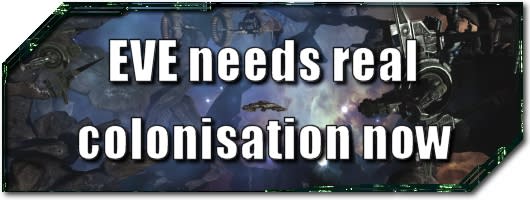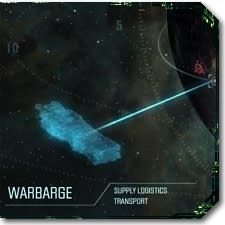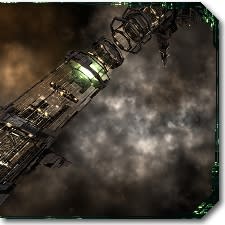EVE Evolved: EVE needs real colonisation now
MMOs have absolutely exploded in popularity over the past decade, with online gaming growing from a niche hobby to a global market worth billions of dollars each year. Once dominated by subscription games like EverQuest and World of Warcraft, recent years have seen free-to-play games take centre stage. Global MMO subscriptions have been reportedly shrinking since 2010, and EVE doesn't appear to be immune to this industry-wide trend. Though February 2013's figures showed EVE subscriptions have technically grown year-on-year, those numbers were published just after the Chinese server relaunch, and CCP hasn't released any new figures since.
Developers have done a good job of catering to current subscribers and polishing existing gameplay with the past few expansions, but the average daily login numbers are still the same as they were over four years ago. EVE will undoubtedly hook in plenty of new and returning subscribers when its deep space colonisation gameplay with player-built stargates and new hidden solar systems is implemented, but time could be running out on these features. Hefty competition is due in the next few years from upcoming sandbox games such as Star Citizen, EverQuest Next, Camelot Unchained, and Elite: Dangerous, and CCP will have to release something big soon to bring in some fresh blood.
In this week's EVE Evolved, I ask whether CCP should focus on new players and suggest plans for two relatively simple colonisation-based expansions that could get EVE a significant part of the way toward its five-year goal in just one year.
Should CCP focus on existing or new players?
From 2008 to 2011, CCP jumped from one big feature to the next in order to draw in as many new players as possible. Devs pumped out faction warfare, wormholes, planetary interaction, and walking in stations during this period. Combined with the fact that a lot of development time was being spent on World of Darkness and DUST 514, this meant that old parts of EVE didn't really get the attention they deserved. Balance issues crept in, UI bugs piled up, and new features received little or no follow-up work. Players eventually snapped during the 2011 monoclegate scandal when it turned out that the years spent working on Incarna had been a waste of time.
Subscriptions reportedly dropped by around 8% in the wake of that disaster, concurrent login numbers dropped to a four-year low, and CCP was forced to lay off 20% of its staff worldwide. CCP promised to refocus its efforts on fixing all of the neglected parts of EVE and catering more to the existing playerbase that pays the bills, and the studio really followed through. EVE Online is now in the most solid and playable state it has ever been in as a result, and at last year's Fanfest, CCP announced plans to start reaching for those big features again without neglecting other areas of the game.
Crucible, Inferno, and Retribution did a great job of stemming the bleeding following monoclegate, but now it's time for a blood transfusion. Odyssey and Rubicon seemed too focused on pleasing existing players and both expansions contributed to a continuing downward trend in average logins. EVE now needs to catch some fresh players and reel in a good number of lapsed veterans, and the best way for developers to achieve that is to bait the hook with blockbuster features.
Expansion #1: Planetary Colonisation
When Planetary Interaction was first announced, developers promised features like territorial districts, population management, pollution, trade agreements, and invasion mechanics. Teaser trailers showed us epic wars over planets and asked whether we'd rule with benevolence or tyranny, but it was all just marketing spin. What we actually got was FarmVille in space: a singleplayer industrial minigame without conflict, challenge, or any of the abovementioned features. I think it's about time CCP delivered on its original promised features and reinvented planetary interaction as a form of competitive empire management for individual players.
With Rubicon's addition of personal deployable structures, there are also plenty of other ways to improve on EVE's lacklustre planetary gameplay. Rich deposits of moon minerals or pirate caches full of loot could be hidden on random planets, and players would have to scan them down using surface probes. Once a deposit is located, the player could anchor an orbital mining laser structure that would drill down to reach it and then start extracting the goods. Drills could even be used on planet-side silos to steal the contents, which would fit right in with the Rubicon expansion's new trend of disrupting passive income.
Expansion #2: Building Stargates
There are a lot of moving parts in CCP's Deep Space Colonisation vision that would all need to be in place to make it work, yet developers have to somehow deliver them over several expansions. The idea of building stargates and using them to visit new unexplored solar systems is intoxicating, but we don't need both features at the same time. Player-built stargates could easily first be introduced as personal deployable structures that can stabilise existing wormholes. The structure could consume fuel to slowly regenerate the wormhole's mass allowance and slow its aging process, allowing it to last for a week or more as long as the mass limit isn't hit and the stargate isn't attacked.
Several different types of stargate could be introduced throughout the expansion cycle, from covert structures that don't show up on the overview to versions with toll-booths that charge for usage. Expensive alliance- or corporation-owned stargates not available to individuals could even come with sentry guns, password locks, and reinforcement timers. This would open amazing strategic options for war and trade, give small gangs more targets, and make exploring through wormholes potentially lucrative for new players who find links worth stabilising. To further tailor this expansion for new players, we could get a new feature that allows players to easily trade bookmarks to discovered cosmic signatures and remotely track whether they've disappeared yet.
With competition on the way, it's more important than ever that EVE bring old players back and appeal to some fresh blood. The only way that's going to happen is if developers can pump out gameplay with more than a few days or weeks of longevity. Features like wormhole stabilisers and orbital mining lasers shouldn't be too difficult to implement, but they would add a lot of replayability to the game and could form part of CCP's deep space exploration plan.
Finding good wormhole connections to stabilise could become a lucrative endeavour for explorers or a standard part of territorial warfare, and a proper system for managing planetary districts would give everyone a taste of EVE's political endgame. Both features can be adapted to work on an individual level and to start at entry level with minimal skill training and would naturally form the basis for further expansions. Developers could slowly unlock the lost territories of the ancient Yan Jung, Talocan and Takmahl empires, open Jove space for colonisation, and even introduce more permanent stargates for alliances to war over.

Brendan "Nyphur" Drain is an early veteran of EVE Online and writer of the weekly EVE Evolved column here at Massively. The column covers anything and everything relating to EVE Online, from in-depth guides to speculative opinion pieces. If you have an idea for a column or guide, or you just want to message him, send an email to brendan@massively.com.






